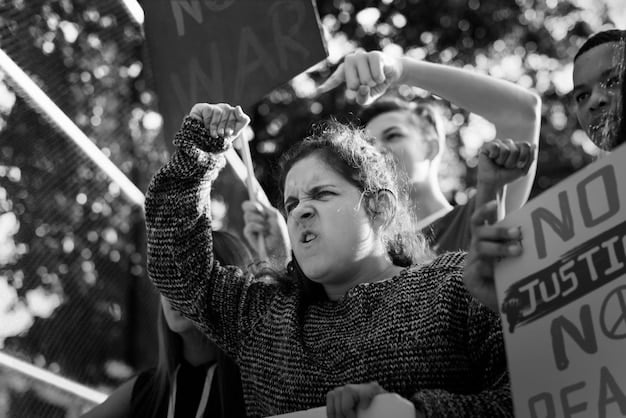Civil Rights Movement’s Impact on 2025 Social Justice Initiatives

Understanding the Civil Rights Movement’s Influence on 2025 Social Justice Initiatives: This article explores how the historical struggles and achievements of the Civil Rights Movement continue to shape and inspire contemporary social justice initiatives in the United States, influencing strategies, goals, and the pursuit of equality in the present day.
How does the past inform the present? This article examines Understanding the Civil Rights Movement’s Influence on 2025 Social Justice Initiatives, uncovering legacies that resound within today’s movements striving for equity and justice.
The Foundations of Today’s Social Justice: A Civil Rights Overview
To understand the impact of the Civil Rights Movement on contemporary social justice initiatives, it’s crucial to revisit its core principles and transformative actions. The movement laid the groundwork for many of the strategies and goals we see in today’s fight for equality.
Exploring this foundation is essential to appreciating the depth and breadth of its enduring legacy.
Key Events and Figures
The Civil Rights Movement was punctuated by pivotal events and shaped by influential leaders. Each played a crucial role in advancing the cause of equality.
- Montgomery Bus Boycott: This seminal event demonstrated the power of nonviolent resistance and collective action against segregation.
- March on Washington: A monumental demonstration that amplified the call for civil and economic rights, highlighted by Martin Luther King Jr.’s iconic “I Have a Dream” speech.
- Rosa Parks: Her courageous act of defiance sparked the Montgomery Bus Boycott, making her a symbol of resistance against racial injustice.
- Martin Luther King Jr.: A visionary leader whose philosophy of nonviolent resistance guided the movement and left an indelible mark on the pursuit of social justice.
These events and figures are cornerstones of understanding the movement’s historical significance.
In summary, the Civil Rights Movement’s history provides critical context for understanding the modern social justice landscape. The strategies and philosophies developed during this period continue to resonate in contemporary movements striving for a more equitable society.
Legal and Policy Achievements: Shaping Modern Frameworks
The Civil Rights Movement achieved landmark legal and policy victories that have fundamentally altered the landscape of American society. These achievements continue to influence the frameworks within which contemporary social justice initiatives operate.
Understanding these legislative milestones is key to appreciating the movement’s lasting impact.

Landmark Legislation
Several key pieces of legislation emerged from the Civil Rights Movement, each designed to dismantle discriminatory practices and protect fundamental rights.
- Civil Rights Act of 1964: This groundbreaking law outlawed discrimination based on race, color, religion, sex, or national origin, impacting employment, education, and public accommodations.
- Voting Rights Act of 1965: This act eliminated discriminatory voting practices, such as literacy tests, ensuring that all citizens could exercise their right to vote, regardless of race.
- Fair Housing Act of 1968: This legislation prohibited discrimination in the sale, rental, and financing of housing, addressing systemic segregation and promoting equal access to housing opportunities.
These legal milestones were crucial in dismantling institutionalized discrimination.
In essence, the legal and policy achievements of the Civil Rights Movement established a foundational framework for contemporary social justice initiatives. These laws provide a legal basis for challenging discrimination and advocating for equal rights in various spheres of society.
The Influence on Contemporary Social Justice Movements in 2025
The Civil Rights Movement’s influence extends far beyond its historical context, deeply shaping contemporary **Understanding the Civil Rights Movement’s Influence on 2025 Social Justice Initiatives** in the United States. Its lessons in nonviolent resistance, coalition building, and legal advocacy continue to inform and inspire activists today.
Exploring this influence reveals the movement’s enduring relevance in addressing modern social injustices.
Black Lives Matter
The Black Lives Matter movement draws direct inspiration from the Civil Rights Movement, employing similar strategies of protest and civil disobedience to address systemic racism and police brutality.
The movement’s focus on racial justice aligns with the core goals of the Civil Rights Movement.
LGBTQ+ Rights
The fight for LGBTQ+ rights has also been significantly influenced by the Civil Rights Movement. Activists have drawn parallels between the struggle for racial equality and the fight for equal rights and protections for LGBTQ+ individuals.
This connection highlights the universality of the pursuit of justice and equality.
In summary, the Civil Rights Movement’s strategies and ideals are readily apparent in contemporary social justice movements. Its emphasis on nonviolent resistance, legal advocacy, and coalition building continues to guide activists in their fight for a more just and equitable society.
Challenges and Criticisms: Acknowledging Limitations and Ongoing Debates
While the Civil Rights Movement achieved significant victories, it faced criticisms and limitations that are essential to acknowledge. Understanding these challenges provides a more nuanced perspective on its legacy and its impact on contemporary social justice initiatives.
Examining these criticisms fosters a deeper understanding of the complexities of social change.

Internal Divisions
The Civil Rights Movement experienced internal divisions over strategies and goals. Some activists advocated for nonviolent resistance, while others favored more radical approaches.
- Integration vs. Separatism: Debates over whether to integrate into mainstream society or pursue separatist agendas created tensions within the movement.
- Pace of Change: Disagreements arose regarding the desired speed of change and the tactics necessary to achieve it.
These divisions reflect the diverse perspectives within the movement.
Socioeconomic Disparities
One critique of the Civil Rights Movement is that it primarily addressed legal and political rights, without fully addressing underlying socioeconomic disparities. Critics argue that economic inequality continues to perpetuate systemic injustice.
- Wealth Gap: The persistent wealth gap between white and minority communities remains a significant challenge.
- Access to Opportunities: Unequal access to education, healthcare, and employment opportunities hinders social mobility and perpetuates inequality.
Addressing these disparities requires comprehensive solutions.
In conclusion, while the Civil Rights Movement made significant strides in advancing equality, it also faced challenges and criticisms. Acknowledging these limitations is essential for a comprehensive understanding of its legacy and its ongoing influence on contemporary social justice initiatives.
Evolving Strategies: Adapting Civil Rights Tactics for Modern Challenges
Contemporary social justice movements are evolving strategies inspired by the Civil Rights Movement while adapting to address modern challenges. These adaptations reflect the changing sociopolitical landscape and the emergence of new forms of activism.
Exploring these evolving strategies is essential to understanding the future of social justice.
Digital Activism
The rise of digital technology has transformed social activism, providing new platforms for organizing, mobilizing, and disseminating information. Social media has become a powerful tool for raising awareness and building support for various causes.
Digital activism complements traditional forms of protest and advocacy.
Intersectionality
Contemporary movements increasingly emphasize intersectionality, recognizing that individuals often experience multiple forms of oppression based on race, gender, sexual orientation, and other identities. This approach seeks to address systemic inequalities in a more holistic manner.
Understanding intersectionality is crucial for effective social justice advocacy.
Grassroots Organizing
Modern social justice initiatives often prioritize grassroots organizing, empowering local communities to address their specific needs and concerns. This approach fosters greater community engagement and ownership of social change efforts.
Grassroots movements are essential for building sustainable social change.
In summary, contemporary social justice movements are adapting strategies inspired by the Civil Rights Movement to address modern challenges. The rise of digital activism, the emphasis on intersectionality, and the prioritization of grassroots organizing reflect the evolving nature of social justice advocacy.
The Road Ahead: Projecting the Civil Rights Movement’s Influence on 2025 and Beyond
As we look towards 2025 and beyond, the Civil Rights Movement’s influence will continue to shape the trajectory of social justice initiatives in the United States. Projecting this influence requires considering emerging challenges and opportunities.
Forecasting the future of social justice necessitates an understanding of historical context and current trends.
- Economic Justice: Addressing economic inequality will remain a central focus of social justice movements. Efforts to raise the minimum wage, expand access to affordable healthcare, and promote equitable economic development will be critical.
- Criminal Justice Reform: Reforming the criminal justice system to address racial bias and reduce mass incarceration will continue to be a priority. Advocacy for police accountability, sentencing reform, and rehabilitation programs will be essential.
- Environmental Justice: Recognizing the disproportionate impact of environmental hazards on marginalized communities will drive the environmental justice movement. Efforts to promote clean energy, reduce pollution, and protect natural resources in underserved areas will gain momentum.
These ongoing struggles require sustained commitment.
In closing, the Civil Rights Movement’s legacy will continue to shape social justice initiatives in the years ahead. By addressing economic inequality, reforming the criminal justice system, and promoting environmental justice, contemporary movements can build upon the foundation laid by the Civil Rights Movement to create a more just and equitable society for all.
| Key Aspect | Brief Description |
|---|---|
| ✊ Civil Rights Act | Outlawed discrimination based on race, color, religion, sex, or national origin. |
| 🗳️ Voting Rights Act | Eliminated discriminatory voting practices, ensuring equal voting rights. |
| 🏠 Fair Housing Act | Prohibited discrimination in housing, promoting equal access to housing. |
| 📱 Digital Activism | Using online platforms to mobilize, organize, and advocate for social justice. |
Frequently Asked Questions
▼
The Civil Rights Movement was a struggle by African Americans in the mid-20th century to achieve equal rights under the law. It was primarily about ending racial segregation and discrimination.
▼
The main goals included ending segregation, achieving voting rights, securing equal access to education and employment, and overall ending racial discrimination in the United States.
▼
It set the stage for understanding inequality while inspiring movements like Black Lives Matter and LGBTQ+ rights. Civil Rights established the legal and moral foundation for modern advocacy.
▼
Intersectionality recognizes the interconnected nature of social categorizations such as race, class, and gender, creating overlapping systems of discrimination or disadvantage. Civil Rights now understand this broader inequality.
▼
Ongoing challenges include addressing economic inequality, reforming the criminal justice system, promoting environmental justice, and combating new forms of discrimination that keep people from fully thriving.
Conclusion
In conclusion, Understanding the Civil Rights Movement’s Influence on 2025 Social Justice Initiatives is essential for navigating contemporary struggles for equality. Its legacy continues to inspire and inform modern movements, guiding efforts to create a more just and equitable society for all.





